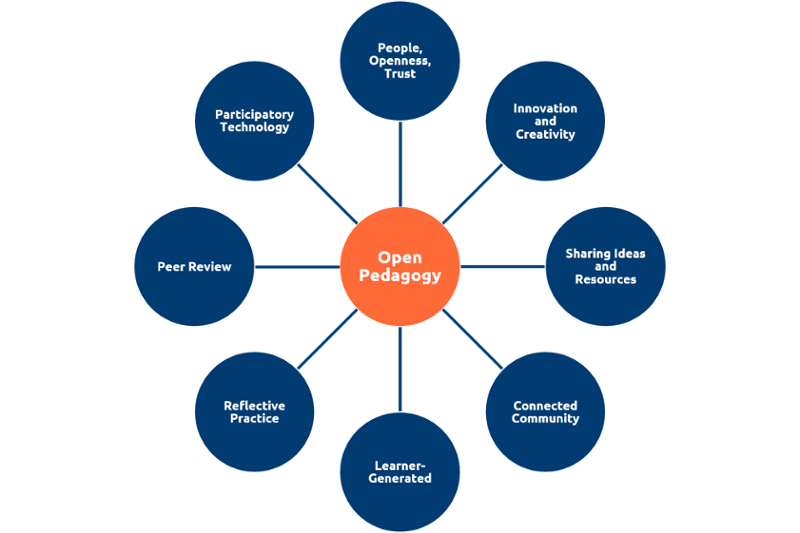Open Pedagogy
Definition
Open educational resources are not just about removing the costs associated with learning material purchases. Instead, OER are about increasing access for students by lessening the financial barriers associated with post-secondary education. Reducing the amount needed to purchase traditional textbooks and other resources means that students have more money for other important parts of their lives, such as childcare, transportation, and housing. Students who are able to obtain their resource without waiting for financial aid or choosing between another important cost are able to start learning earlier in their courses. Students have greater agency in the way they obtain and consume educational material, and are able to learn in a way that they prefer (e.g., print, online) or with accessibility software support.
Explanation
Open educational resources are part of a larger, global strategy called open education. Open education seeks to create an environment of collaboration in the classroom, through the open sharing of knowledge, evaluation practices, and other procedures between students and professors.
Application
Hegarty (2015) describes eight attributes of open pedagogy.
People, openness, trust: Working with others should be viewed as imperative. Students and instructors may need support to embrace this openly and to trust others to get the work done.
Innovation and creativity: Creativity and innovation in teaching and learning is essential to open pedagogy. Encourage students to try new things and give them the opportunity to do so without the need for lengthy discussions or approvals.
Sharing ideas and resources: Disseminate knowledge by encouraging the sharing of ideas with others. This might also include the community outside of the classroom.
Connected community: Encourage students to work as a part of a connected community of scholars and professionals.
Learner-generated: Facilitate student participating in the learner process as contributors to knowledge, not just as consumers of knowledge. Students can participate in formal or informal creation of learning resources, which can include OER.
Reflective practice: Provide opportunities for students and instructors to engage in reflective practice about the teaching and learning process.
Peer review: Allow students to display the results of their learning and work to others. Teach students how to give and receive constructive feedback.
Participatory technology: Provide technology that allows students to engage in ways that are meaningful to them. This might include social media, like Discord, or collaborative apps like Google Workspace.

Examples
Democratize your syllabus
Using accessible, friendly, and supportive language in your syllabus or course outline is a way to build trust in students. You may want to engage portions of the Liquid or Human Syllabus to encourage students to engage with you and to build community. This might include:
- Accessible formats
- Mobile-friendly formats
- Supportive language
- Friendly, imperfect welcome video
Not only is this a departure from standard, policy-heavy syllabi, it can make the class seem more welcoming for students from non-majority groups, who are more likely to enter a course from a place of distrust.
You can also start your class with openness in mind by asking students to participate in the creation of definitions in the syllabus. This might include:
- Class code of conduct
- Options and choices for topics/delivery methods for various assignments
- Opportunities for students to lead class sessions
- Give input on marking schemes, etc.
Benefits to allowing for student input in the syllabus include increased engagement, higher order thinking, fewer missed assignments/deadlines, and more fun!
It's important to work within the guidelines at the university for our standard Course Outline.
- Provide human or visual syllabus in addition to standard course outline
- Establish percentages for course grading (e.g., exams = 30%, assignments = 20%) but leave choices and room for flexibility within (e.g., take home exams, choice of assignment topic/format) when class starts
- Link both options in Canvas
Use non-disposable assignments
Disposable assignments are assignments that add little value to the academic world and the community at-large. Students spend a lot of time and effort creating them, instructors spend a lot of time grading them, and the student disposes of the assignment after receiving the grade, often never looking at it again.
Non-disposable assignments are created to engage students in meaningful application of their learning by allowing them to inject meaning, value, purpose, identity and autonomy into the work.
Non-disposable assignments are characterized by Seraphin et al. (2019) as:
- Collaborative. Students work together and participate in exchange that is closely aligned to the collaboration and teamwork found in the workplace.
- Allowing for revision. Opportunities for revision, modification, and creativity are built into the assignment and its deadlines.
- Sharing outside of the student-teacher partnership. Opportunities exist for the assignment to be shared to peers inside and outside of the classroom, and to the community.
- Peer critique. Students have the chance to engage with their peers to improve their work, identify strengths, and make advancements in their learning.
- Innovative. Non-disposable assignments aim to have students create and add to knowledge, not simply reiterate existing information.
Examples of non-disposable assignments can include:
- Editing or creating articles on Wikipedia
- Creating public-facing tutorials, videos, or learning objects
- Creating study questions (and answers) for students
- Creating a collaborative OER
- Editing or annotating existing OER
- Simulated journal peer review
- Digital storytelling
- Conducting research, rather than planning or analyzing research
